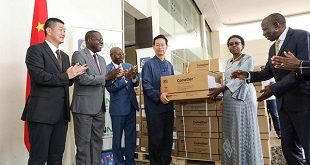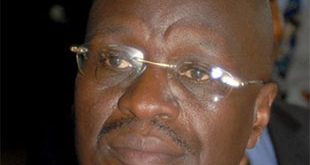
Ministry of Health to carry out multi-drug resistant TB survey
| PATRICIA AKANKWATSA | The Ministry of Health on July 3 revealed that a nationwide survey to determine the burden of Multi-Drug Resistant Tuberculosis (MDRTB) in the country is to be carried out at the end of July and will be funded by USAID.
Dr Raymond Byaruhanga, a senior technical advisor at the National Control TB and Leprosy Programme at the Ministry of Health says current figures on the disease are not accurate since it is believed that some cases of the condition are not diagnosed.
It is estimated that so far 60 people being treated for multi-drug resistant tuberculosis have recently succumbed to the disease.
Medical doctors say the number is too high since the globally allowed figure is 5% of all detected cases. Annually, an estimated 1,500 cases of MDRTB are registered in the country either as first-time or progressive infections.
Dr Abel Nkolo the head of the defeat TB program in Uganda attributes the high number of deaths to the comorbidities that they have.
“These are very sick patients who can die from anything either from the disease itself or comorbidities like HIV, anaemia, hypertension, or renal disease,” he said.
In addition to comorbidities, side effects of TB medication have also been linked to deaths. It is believed that the drugs have high levels of toxicity that can lead to deafness, kidney failure, and even death in some cases.
To prevent the deaths, Dr Nkolo says high dependency units are needed for TB patients. He adds that for this to happen, the government needs to invest more in TB care.
“When patients with MDRTB end up in the hospital, they need special care. Many of them need to be put on oxygen to help with their breathing and even monitor other body organs. As of now we do not have those units in place but are working with what we have to ensure that these patients get the care that they need,” he said.
“There is limited access to drug susceptibility tests, and an unreliable second-line drug management system, with no contact tracing of contacts of index cases besides limited expertise in case management and poor access to treatment,” he adds.
He also says that there are low levels of sputum follow-up examinations; loss of specimens during transportation; drug stock-outs; lack of appropriate isolation spaces, and limited funding.
Dr Kyabayinze says that another issue associated with MDRTB is stigma.
“Stigma is a recognised challenge affecting the prevention, diagnosis, treatment, and care of infectious diseases, including TB,”
“Stigma is a complex social construct shaped by inadequate knowledge and information about modes of transmission, care, and prevention and is exacerbated by the inadequate availability of TB services and low-quality services, especially in rural areas,”
Better picture
Dr Daniel Kyabayinze, the Director of Public Health at the Ministry of Health says the survey will enable the government to plan appropriately and give a better picture of the prevalence of the disease in the country.
“The survey will help inform us and direct our response to the disease. At the moment we have old data,” said.
Uganda is one of the 30 WHO-designated countries with a high burden of TB/HIV. In 2019, the estimated incidence rate for TB was 200 per 100,000 population and the mortality rate was 35 per 100,000 population.
In 2019, 65,897 TB cases were notified. In the same year, the World Health Organisation (WHO) estimated that 1% of new cases and 12% of previously treated cases were Multi Drug-Resistant
Worldwide, Drug-resistant Tuberculosis (DR-TB) remains a big challenge with Multidrug-resistant TB and extensively drug-resistant TB (XDR-TB) being the worst forms.
The 2020 TB Global Report released by the WHO showed that only 33% of patients with MDRTB could access treatment. This means around 67% of MDRTB cases go undetected, which means they are not in treatment and spreading the disease to unsuspecting people.
MDR-TB is defined as TB that is resistant to at least the two most powerful first-line medicines (Rifampicin and Isoniazid).
Dr Kyabayinze says that the survey is also supposed to help show where the people with the disease who do not get treatment are.
“It is estimated that 1,000 Ugandans with MDRTB are not on treatment,” he says.
The lack of treatment for most MDRTB patients perpetuates an ongoing transmission posing a major threat to the community around these patients.
More investment
Dr Byaruhanga says the government is working towards investing more in TB care in the country.
“It is true that more investments for MDRTB are needed. At the moment majority of the treatment depends on donors but the government is working towards increasing investments in TB care. The government is now procuring all first-line TB drugs and we believe that shortly, spending more MDRT would have increased,” he said.
In addition to increasing investment, Dr Nkolo says more work needs to be done to track all MDRTB patients.
“Now we can only track around 450 to 500 TB patients annually. But we know that an estimated 1,000 go undetected which affects treatment outcomes for the disease,”
“They stay in the community and continue to spread the disease. Every untreated TB patient can spread the disease to about 15 others every year. The good news is that TB is curable and treatment is freely available at all TB treatment facilities in the country. To identify and minimise TB infection among all people, there is an urgent need for individual and collective responsibility and the time is now,” Dr Nkolo said
To have more people surviving, we need to make sure all people are on treatment and complete it,”
****
 The Independent Uganda: You get the Truth we Pay the Price
The Independent Uganda: You get the Truth we Pay the Price



